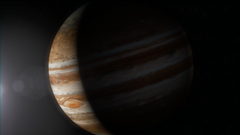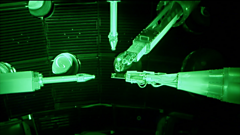
Scientists start to peel back the layers of Jupiter to reveal the wonders within, using information gained from Nasa's Juno mission.
'To send a spacecraft there is a little bit insane,' says Scott Bolton when talking about Jupiter, the largest planet in the solar system. But that is exactly what he has done, because Scott is head of Juno, the Nasa mission designed to peer through Jupiter's clouds and reveal the wonders within.
Professor Kaitlin Kratter shows us how extreme Jupiter is. She has come to a quarry to measure out each planet's mass with rocks, starting with the smallest. Mercury is a single kilogram, and the Earth is 17. Jupiter is seven tonnes - that is two and a half times the mass of all the other planets combined. With extreme size comes extreme radiation. Juno is in the most extreme environment Nasa has visited. By projecting a 70-foot-wide, life-size Juno on a Houston rooftop, Scott shows us how its fragile electronics are encased in 200kg of titanium.
Professor Andrew Ingersoll, Juno's space weatherman, reveals they have seen lightning inside Jupiter, perhaps a thousand times more powerful than Earth's lightning. This might be evidence for huge quantities of water inside Jupiter. He also tells us that the Great Red Spot, a vast hurricane-like storm that could swallow the Earth whole, goes down as far as they can see.
At the National Ignition facility in northern California, Dr Marius Millot is using lasers normally used for nuclear fusion for an experiment. He uses '500 times the power that is used for the entire United States at a given moment' to crush hydrogen to the pressures inside Jupiter. Under these extreme conditions, hydrogen becomes a liquid metal. Juno is finding out how much liquid metallic hydrogen is inside Jupiter, and scientists hope to better understand how this flowing metal produces the most powerful aurora in the Solar System.
But what is at Jupiter's heart? In Nice, Professor Tristan Guillot explains how Juno uses gravity to map the planet's centre. This can take scientists back to the earliest days of the solar system, because Jupiter is the oldest planet and it should contain clues to its own creation. Tristan reveals there is a huge rocky core - perhaps ten times the mass of Earth. It is now thought Jupiter started as a small rocky world. But there is a surprise, because Juno's findings suggest this core might be 'fuzzy'. Tristan thinks the planet was bombarded with something akin to shooting stars.
Last on
More episodes
Previous
Clips
-
![]()
Trail - Jupiter Revealed
Duration: 02:39
-
![]()
Jupiter on Earth
Duration: 02:24
-
![]()
Juno
Duration: 02:20
Music Played
Timings (where shown) are from the start of the programme in hours and minutes
-
![]() 00:06
00:06Mogwai
SCRAM
-
![]() 00:20
00:20Nathan Fake
You Are Here (Tet Remix)
-
![]() 00:27
00:27Boards of Canada
Reach for the Dead
-
![]() 00:40
00:40Plaid
Do Matter
Credits
| Role | Contributor |
|---|---|
| Series Producer | Rob Liddell |
| Producer | Tom Hewitson |
| Director | Tom Hewitson |
| Editor | Steve Crabtree |
Broadcasts
- Tue 7 Aug 2018 21:00麻豆官网首页入口 Two except Scotland
- Tue 7 Aug 2018 23:15麻豆官网首页入口 Two Scotland
- Tue 11 Sep 2018 01:15
- Mon 24 Sep 2018 23:45麻豆官网首页入口 Two except Northern Ireland
- Thu 24 Jan 2019 23:15
- Sun 27 Oct 2019 23:40麻豆官网首页入口 Two England & HD only
- Sun 13 Dec 2020 23:30
- Sun 8 Aug 2021 22:35
- Mon 9 Aug 2021 02:25
- Mon 29 Aug 2022 23:30麻豆官网首页入口 Two except Scotland
- Tue 26 Sep 2023 23:15麻豆官网首页入口 Two except Scotland




